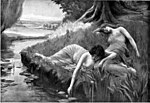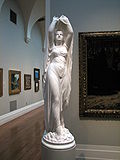Queen of Elphame or "Elf-hame" (-hame stem only occurs in conjectural reconstructed orthography), in the folklore belief of Lowland Scotland and Northern...
21 KB (2,379 words) - 16:29, 6 August 2024
by the "Quene of Elphen." Scholar Robert Pitcairn reconstructed the word as "Elphame" or "Elf-hame." The concept of a Dianic queen of spirits influenced...
17 KB (2,078 words) - 21:56, 26 September 2024
legendary creature or type of hobgoblin comparable to the boogeyman (or bugaboo or babau or cucuy), and other creatures of folklore, all of which were historically...
3 KB (345 words) - 16:40, 2 November 2023
like "imps of serpents", "imp of hell", "imp of the devil", and so on; and by the 17th century, it came to mean a small demon, a familiar of a witch. The...
7 KB (880 words) - 16:16, 8 October 2024
beings such as sprites, elves, fairies, etc. has been common in many parts of the world, and might to some extent still be found within neo-spiritual and...
4 KB (322 words) - 14:21, 30 April 2024
"The Naughty Boy" and "The Travelling Companion" in the second installment of Fairy Tales Told for Children. Thumbelina is about a tiny girl and her adventures...
14 KB (1,413 words) - 19:07, 20 August 2024
to as the Queen of Elfland. Poet and novelist Robert Graves published his alteration of the ballad, replacing her name with "Queen of Elphame": I'm not...
7 KB (784 words) - 16:37, 18 February 2024
Fairies, particularly those of Irish, English, Scottish and Welsh folklore, have been classified in a variety of ways. Classifications – which most often...
8 KB (900 words) - 19:11, 18 July 2024
and further from incubāre ("to lie upon, to hatch"). One of the earliest evident mentions of a demon sharing qualities with an incubus comes from Mesopotamia...
15 KB (1,788 words) - 08:04, 4 October 2024
Cat-sìth (section The King of the Cats)
population of the European wildcat, which is now absent from elsewhere in the British Isles). The cat-sìth is all black with the exception of a white spot...
7 KB (694 words) - 07:22, 15 May 2024
völva divine figure Huld and the German Holda. The word hulder is only used of a female; a "male hulder" is called a huldrekall and also appears in Norwegian...
6 KB (666 words) - 16:31, 17 September 2024
Seelie is a term for fairies in Scottish folklore, appearing in the form of seely wights or The Seelie Court. The Northern and Middle English word seely...
8 KB (829 words) - 07:12, 19 June 2024
alchemical works from around the time of the European Renaissance, and particularly elaborated in the 16th century works of Paracelsus. According to Paracelsus...
15 KB (1,842 words) - 20:18, 15 September 2024
The redcap (or powrie) is a type of malevolent, murderous goblin found in folklore of the Anglo-Scottish border region. The redcap is said to inhabit ruined...
7 KB (910 words) - 17:52, 7 October 2024
A water spirit is a kind of supernatural being found in the folklore of many cultures: Some water spirits in traditional African religion include: Mami...
7 KB (801 words) - 09:53, 29 September 2024
Headless Horseman (redirect from Headless Horseman (Legend of Sleepy Hollow))
The Headless Horseman is an archetype of mythical figure that has appeared in folklore around Europe since the Middle Ages. The figures are traditionally...
19 KB (2,120 words) - 17:41, 1 October 2024
sources describing Nicneven as a fairy queen or goddess. Elf Fairy Queen of Elphame Wild Hunt Simpson, Jacqueline (1995). "'The Weird Sisters Wandering': Burlesque...
10 KB (1,362 words) - 17:35, 13 March 2024
Fairy (section Spirits of the dead)
queen of Spenser. pt. 1. Taylor & Francis. ISBN 978-0-415-21958-7. Warton, Thomas (2001). Spenser's Faerie Queene: Observations on the Fairy queen of...
63 KB (8,244 words) - 07:39, 23 September 2024
The Dullahan (Irish: Dubhlachan; dúlachán, /ˈduːləˌhɑːn/) is a type of legendary creature in Irish folklore. He is depicted as a headless rider on a black...
25 KB (2,381 words) - 21:47, 11 October 2024
Spriggan (category Culture of Cornwall)
or if cattle were stolen. In one story, an old woman got the better of a band of spriggans by turning her clothing inside-out (turning clothing supposedly...
6 KB (724 words) - 22:39, 30 July 2024
mythological creature present in the Tupi–Guarani myths in the Amazon rainforest of Brazil. The name comes from the Tupi language kuru'pir, meaning "covered in...
8 KB (1,015 words) - 09:26, 29 September 2024
but which since the spread of Christianity has often been considered mischievous.(p320) Shakespeare identifies the character of Puck in his A Midsummer Night's...
13 KB (1,378 words) - 13:27, 17 August 2024
Green Man (redirect from Green Men of Birmingham)
in architecture and art, of a face made of, or completely surrounded by, foliage, which normally spreads out from the centre of the face. Apart from a purely...
19 KB (2,210 words) - 00:14, 6 October 2024
The origins of narratives about the creature are unclear, but the practical purposes of keeping children away from dangerous stretches of water and warning...
32 KB (3,742 words) - 02:21, 14 August 2024
to a vampire, but its behavior is more akin to that of the incubus. It is distinct from both of these creatures in that it wears a magic hat called a...
18 KB (2,385 words) - 12:45, 4 June 2024
goblin is a small, grotesque, monstrous creature that appears in the folklore of multiple European cultures. First attested in stories from the Middle Ages...
18 KB (1,769 words) - 00:20, 10 October 2024
Oberon (category Matter of France)
is King of the Fairies and spouse of Titania, Queen of the Fairies. Oberon is a variant spelling of Auberon, earlier Alberon, the origin of which is...
18 KB (2,285 words) - 18:23, 29 July 2024
Nuckelavee (category Culture of Orkney)
elements. British folklorist Katharine Briggs called it "the nastiest" of all the demons of Scotland's Northern Isles. The nuckelavee's breath was thought to...
17 KB (1,808 words) - 06:25, 14 July 2024
Púca (section Nature of the púca)
pooka, phouka, puck is a creature of Celtic, English, and Channel Islands folklore. Considered to be bringers both of good and bad fortune, they could...
16 KB (2,041 words) - 08:03, 9 October 2024
does not die," are a few of the earliest evidences of the spiritual connection of bisimbi to the land of the living and the land of the dead. The word basimbi...
12 KB (1,241 words) - 07:02, 16 August 2024





















